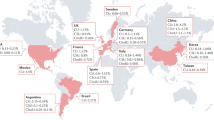Abstract
Urticaria is dermal edema resulting from vascular dilatation and leakage of fluid into the skin in response to molecules released from mast cells. The major preformed mediator histamine produces a prototypic, short-lived urticaria. However, the clinical spectrum and pattern of lesions indicate that other molecules, including prostaglandins, leukotrienes, cytokines, and chemokines, produced at different times after mast cell activation contribute to the polymorphism of this symptom and the variable evolution of this disease. It is a common practice to distinguish immunological and nonimmunological urticaria. Immunological urticaria is a hypersensitivity reaction mediated by antibodies and/or T-cells that results in mast cell activation. Although immunoglobulin (Ig)E-mediated type I hypersensitivity (HS) was long postulated to be the major immunological pathway associated with mast cell activation, interaction between IgE-bound mast cells and allergens is unlikely to be the mechanism by which urticaria develops in most patients. It is now well established that urticaria may result from the binding of IgG auto-antibodies to IgE and/or to the receptor for IgE molecules on mast cells, thus corresponding to a type II HS reaction. These auto-immune urticarias represent up to 50% of patients with chronic urticaria. Mast cell activation can also result from type III HS through the binding of circulating immune complexes to mast cell-expressing Fc receptors for IgG and IgM. Finally, under certain circumstances, T-cells can induce activation of mast cells, as well as histamine release (type IV HS). Nonimmunological urticarias result from mast cell activation through membrane receptors involved in innate immunity (e.g., complement, Toll-like, cytokine/chemokine, opioid) or by direct toxicity of xenobiotics (haptens, drugs). In conclusion, urticaria may result from different pathophysiological mechanisms that explain the great heterogeneity of clinical symptoms and the variable responses to treatment.
Similar content being viewed by others
References
French Consensus Conference. (2003), Eur J Dermatol 13, 385–392.
Kaplan, A. P. (2004), J Allergy Clin Immunol 114, 465–474.
Doutre M. S. (1999). Eur J Dermatol 9, 601–605.
Berard, F., Saint Mezard, P., Cousin, F., Mecheri, S., Nicolas, J. F. (2003), Ann Dermatol Venereol 130, 1S10–1S15.
Luquin, E., Kaplan, A. P., and Ferrer, M. (2005), Clin Exp Allergy 35, 456–460.
Kinet, J. P. (1999), Annu Rev Immunol 17, 931–972.
Beaven, M. A. and Metzger, H. (1993), Immunol Today 14, 222–226.
Kitao, A., Nobuhara, S., Kore-Eda, S., Takahashi, K., Nishigor, C., Miyachi, Y. (2001), Eur J Dermatol 11, 440–442.
Frandji, P., Mourad, W., Tkaczyk, C., et al. (1998), Eur J Immunol 28, 844–854.
Grattan, C. E., O'Donnell, B. F., Francis, D. M. et al. (2000), Br J Dermatol 143, 365–372.
Goodarzi, K., Goodarzi, M., Tager, A. M., Lester, A. D., Von Andrian, V. H. (2003), Nat Immunol 4, 965–973.
Pacor, M. L., Di Lorenzo G., and Corrocher, R. (2001), Clin Exp Allergy 31, 1607–1614.
Zhu, F. G. and Marshall J. S. (2001), J Leukoc Biol 69, 253–262.
Fujii, K., Konishi, K., Kanno, Y., Ohgou, N. (2001), J Dermatol 28, 248–250.
Eymard, B., Cousin, F., and Nicolas, J. F. (2003), Ann Dermatol Venereol 130, 787,788.
Cousin, F., Philips, K., Favier, B., Bienvenu, J., and Nicolas, J. F. (2001), Eur J Dermatol 11, 181–187.
Barbaud, A. (2001), Ann Dermatol Venereol 128, 1161–1165.
Bourrain, J. L. (2001), Ann Dermatol Venereol 128, 1139–1141.
Greaves, M. W. (2003), Curr Opin Allergy Clin Immunol 3, 363–368.
Sabroe, R. A., Fiebiger, E., Francis, D. M. et al. (2002), J Allergy Clin Immunol 110, 492–499.
Ferrer, M., Nakazawa, K., and Kaplan, A. P. (1999), J Allergy Clin Immunol 104, 169–172.
Supajatura, V. Ushio, N., Nakao, A., Okumara, K., Ra, C., and Ogawa, H. (2001), J Immunol 167, 2250–2256.
Miyajima I., Dombrowicz, D., Martin, T. R., Ravetch, J. V., Kinet, J. P., and Galli, S. J. (1997), J Clin Invest 99, 901–914.
Malbec, O., Friedman, W. H., and Daeron, M. (1999), Curr Top Microbiol Immunol 244, 13–27.
Zhu, D., Kepley, C. L., Zhang, K., Terada, T., Yamada, T., and Saxon, A. (2005), Nat Med 11, 446–449.
Gauchat, J. F., Henchoz, S., Mazzei, G., et al. (1993), Nature 365, 340–343.
Malaviya, R., Ikeda, T., Ross, E., and Abraham, S. N. (1996), Nature 381, 77–80.
Skokos, D., Lepanse S., Villa, I., et al. (2001), J. Immunol 166, 868–876.
Inamura, N., Mekori, Y. A., Bhattacharyya, S. P., Bianchine, P. J., and Metcalfe, D. D. (1998), J Immunol 160, 4026–4033.
Bhattacharyya, S. P., Drucker, I., Reshef, T., Kirshenbaum, A. S., Metcalfe, D. D., Mekori, Y. A. (1998), J Leukoc Biol 63, 337–341.
de Paulis, A., Annunziato, F., Digioa, L., et al. (2001), Int Arch Allergy Immunol 124, 146–150.
Petersen, L. J., Brasso, K., Pryds, M., and Skou, P. S. (1996), J Allergy Clin Immunol 98, 790–796.
Schubert B., Grosse Perdekamp, M. T., Pfeuffer, P., Raith, P., Brocker, E. B., Trautmann, A. (2005), Eur J Dermatol 15(3), 164–167.
Bircher, A. J. (1999), Eur J Dermatol 9, 601–605.
MacGlashan, D. W. Jr., Bochner, B. S., Adelman, B. C., et al. (1997), J Immunol 158, 1438–1445.
Choi, I. S., Koh, Y. I., Chung, S. W., and Lim, H. (2004), J Korean Med Sci 19, 724–728.
Author information
Authors and Affiliations
Corresponding author
Rights and permissions
About this article
Cite this article
Hennino, A., Bérard, F., Guillot, I. et al. Pathophysiology of urticaria. Clinic Rev Allerg Immunol 30, 3–11 (2006). https://doi.org/10.1385/CRIAI:30:1:003
Issue Date:
DOI: https://doi.org/10.1385/CRIAI:30:1:003




